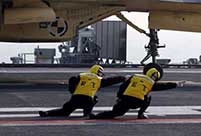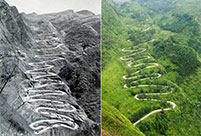

 |
| (File photo) |
CANBERRA, July 31 -- One of Australia's leading oceanographers said on Friday that the airplane debris found on Reunion Island this week is likely to be from Malaysia Airlines' Flight MH370 because the discovery is consistent with industry predictions that wreckage would eventually end up on the east coast of Africa.
Dr David Griffin, an oceanographer from the Commonwealth Scientific and Industrial Research Organization (CSIRO), told Xinhua he believed the debris belonged to the missing Boeing 777 airliner because the scientific pattern of currents in the southern Indian Ocean would have carried it in that direction.
Griffin said his team had initially predicted any wreckage from MH370 would probably wash up on the coast of Madagascar, which is less than 750 km from Reunion.
The CSIRO team felt this was the most likely outcome given the strong currents pass the existing airplane search area off the coast of southwest Australia - before heading north then west towards Africa.
"The Indian Ocean has a generally eastward movement in the south, south of Perth, but then it goes westward north of tropical Australia," he said.
"So where we think the plane went down, we think debris would have initially gone northward (along the coast of Australia) before being caught in the westward current.
"It then gets caught on a line around 30 degrees south, which ends up slightly south of Reunion."
But despite the sea's currents following generally predictable patterns, Griffin said that narrowing down the search area for the plane would be difficult.
"We can't really discriminate where along the (northward) arc the plane could be," he said.
The piece of debris found on Reunion Island is thought to be a flaperon - a small, lightweight piece attached to the wing, which aviation experts and oceanographers believe could have stayed afloat while other, heavier pieces of the aircraft sunk.
Griffin added if floating debris got caught in a current, it could be taken thousands of kilometers from its origin - which is thought to be southwest of Perth in Australia.
The ill-fated jet was declared missing on March 8, 2014 after it vanished without a trace en route from Kuala Lumpur to Beijing. Initial investigations determined it had headed south towards the Indian Ocean near Australia.
"In a general sense, the idea of (debris) crossing the Indian Ocean in this amount of time is well explained by the models," Griffin said.
He added that if other floating pieces were taken by the currents, then Madagascar and Reunion were the likely places they could end up.
"There aren't really other places of landfall debris could end up. Madagascar would be worth keeping an eye on."
Other oceanographers around the country are in furious agreement over the likelihood of sea patterns moving the debris, with Professor Charitha Pattiaratchi from the University of Western Australia saying his research was similar to that of the CSIRO.
He said the fact the debris washed up on Reunion meant the search area for the stricken jet - in the eastern Indian Ocean - was "definitely" on the right track.
"Our model results that we did last year predicted that within 18-24 months after the crash, it was a possibility that it would have ended up within that region," Pattiaratchi told The New Daily on Thursday.
"(The origin of the debris) will definitely be in the Southern Hemisphere, it would be to the east, it would cover definitely the area of the physical search at the moment."
Meanwhile aviation expert Neil Handsford said the flaperon was a likely piece of an airplane to be found as it was lightweight compared to other parts of the plane.
"(The flaperon) is a composite material, it's carbon fiber, it' s not aluminum so it has more chance of floating because it's lightweight," he told the Australian Broadcasting Corporation on Thursday.
All 239 passengers on board MH370 are presumed dead after it went missing not long after takeoff.
The physical search for the jet is now halfway through, and covers more than 120,000 square kilometers of sea bed.
 Student proposes during graduation ceremony
Student proposes during graduation ceremony China-made special vehicles in exhibition
China-made special vehicles in exhibition Soldiers serving at Liaoning aircraft carrier
Soldiers serving at Liaoning aircraft carrier Bikini beauties lifeguards in river rafting place
Bikini beauties lifeguards in river rafting place PLA soldiers eat raw snake meat in harsh training
PLA soldiers eat raw snake meat in harsh training Kiss contest held in Nanning, SW China
Kiss contest held in Nanning, SW China Yunnan-Myanmar Road: The past and present
Yunnan-Myanmar Road: The past and present Photos of beautiful policewoman become online hit
Photos of beautiful policewoman become online hit Campus belle of Xiamen University gets popular online
Campus belle of Xiamen University gets popular online Talents return for Party
Talents return for Party Sino-Turkish ties can overcome conflicts
Sino-Turkish ties can overcome conflicts Turkish president opposes terror against China
Turkish president opposes terror against China MH370: Debris similar to lost plane found in southern Indian Ocean
MH370: Debris similar to lost plane found in southern Indian OceanDay|Week